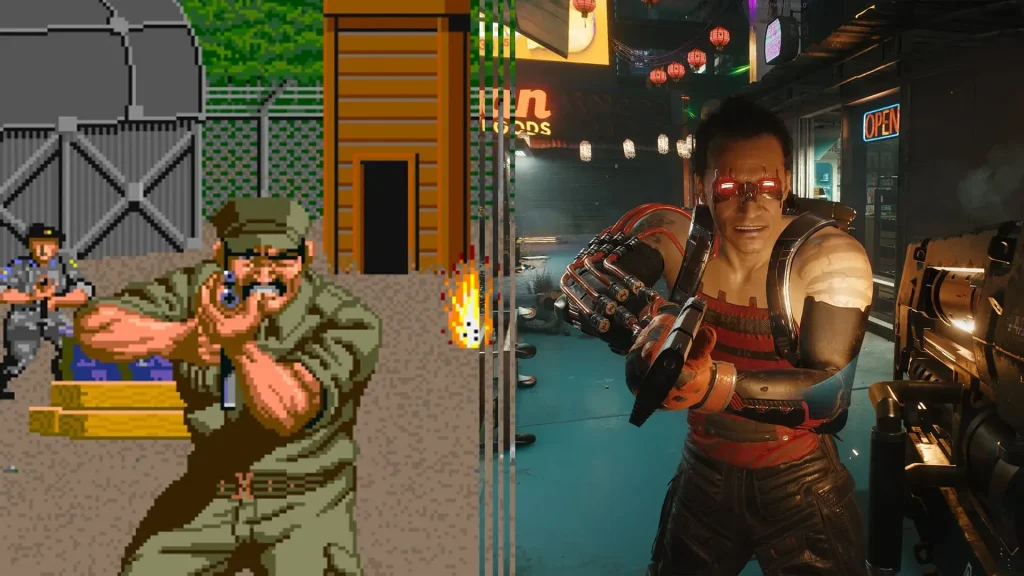Evolution of Gaming Graphics is a narrative about how technology, artistry, and constraints shaped our favorite virtual worlds. In the early days, pixel art games showed how mood and story could be conveyed with limited color palettes, sprites, and clever tiling. As graphics hardware evolution accelerated, developers could push richer textures, dynamic lighting, and more ambitious worlds beyond flat sprites. Tech milestones introduced shading models and real-time effects that paved the way for ray tracing in gaming. Later, physically based rendering in gaming gave artists reliable rules for material appearance, light interaction, and immersive atmosphere.
Today, discussions about game visuals pivot from sheer specs to rendering philosophy, exploring how stylized art, procedural shading, and cinematic lighting coexist with performance constraints. Rendering pipelines now blend rasterization with advanced illumination techniques, enabling believable surfaces and real-time global illumination without sacrificing interactivity. Industry conversations also focus on upscaling technologies, AI-driven denoisers, and hardware-aware pipelines that keep games looking sharp across diverse devices. Across the broader arc of digital visuals, the goal remains balancing artistic direction with technical possibility to deliver immersive, responsive worlds.
Evolution of Gaming Graphics: From Pixel Art to Real-Time Ray Tracing and the History of Gaming Graphics
The journey begins in the Pixel Art Era, where developers turned limited palettes and tile-based layouts into lively worlds. Pixel art games depended on clever dithering, sprite management, and bold color choices to convey mood and motion, while CRT displays added a soft glow that blurred harsh edges and gave scenes a tangible warmth. This era embodies the history of gaming graphics, showing how constraints can inspire expressive design and how players learned to read textures, lighting, and depth from a handful of pixels and colors.
As hardware advanced, games moved from flat sprites to three-dimensional spaces that could be explored in real time. The dawn of 3D introduced polygons, textures, and shading pipelines, along with challenges like depth perception and texture mapping on complex surfaces. This shift also marked the start of the graphics hardware evolution, where increasing memory bandwidth and programmable shaders opened doors to effects such as dynamic lighting, depth-based parallax, and more convincing geometry. The era set the stage for a broader conversation about realism, performance, and the evolving language of visuals in games, ultimately paving the way for physically based rendering and sophisticated lighting models.
Modern Stylization and AI-Driven Rendering for Pixel Art Games: The Resilient Aesthetics in a Ray-Traced World
Today, pixel art games continue to thrive, proving that stylization can coexist with modern rendering techniques. In high-definition and VR contexts, retro-inspired visuals are reimagined with crisp edges, scalable palettes, and thoughtful shading that respects the original charm while embracing contemporary lighting. The modern pixel art aesthetic demonstrates how history and innovation intersect: players experience familiar silhouettes and color constraints, yet benefit from improved anti-aliasing, shader fidelity, and upscaled resolutions that preserve legibility at any distance.
Alongside stylization, physically based rendering in gaming guides artists toward consistent material behavior under varying lighting, enabling believable metals, plastics, and fabrics even in stylized works. AI-based upscaling, denoisers for ray-traced frames, and hybrid rendering pipelines blend rasterization and selective ray tracing to achieve smoother performance without sacrificing visual quality. This trajectory reflects ongoing graphics hardware evolution, where advances in GPUs and new rendering paradigms—combined with AI-driven tools—continue to expand what’s possible in both pixel art aesthetics and photo-realistic scenes.
Frequently Asked Questions
How did the Evolution of Gaming Graphics drive the shift from pixel art games to physically based rendering in gaming, and what role did graphics hardware evolution play?
The Evolution of Gaming Graphics chronicles the move from pixel art games to physically based rendering in gaming. Graphics hardware evolution—faster GPUs, higher memory bandwidth, and programmable shaders—made real-time shading and complex materials feasible. Physically based rendering introduced consistent material behavior with albedo, metallic/roughness, and normal maps, allowing artists to predict how surfaces respond to light across scenes. This hardware-driven progress expanded textures, lighting, and geometry, turning retro aesthetics into richer, more believable virtual worlds.
What is the impact of ray tracing in gaming on the Evolution of Gaming Graphics, and how do hybrid rendering approaches balance realism with performance?
Ray tracing in gaming brings real-time light, shadows, and reflections that raise the Evolution of Gaming Graphics toward cinematic lighting. Because full ray tracing at high frame rates is demanding, developers often use hybrid rendering—rasterization for performance with selective ray tracing for lighting and reflections—to balance quality and speed. AI-driven denoisers and upscaling help deliver convincing visuals across a range of hardware, illustrating how advances in rendering paradigms and hardware continue to shape the evolution of gaming graphics.
| Era / Topic | Core Idea | Key Technologies / Techniques | Impact on Graphics |
|---|---|---|---|
| Pixel Art Era | Simplicity under resource constraints; distinctive aesthetic | Pixel art, tile maps, sprite sheets, dithering; CRT glow | Creativity flourishes within limits; iconic, readable visuals; early visual language |
| From Pixels to Polygons: The Dawn of Real-Time 3D | Real-time 3D enables volume, perspective, and exploration of 3D worlds | Polygons, textures, Z-buffer; real-time shading; 3D models; 2D sprites in 3D or pseudo-3D | Introduces depth and space; broad design possibilities; mixed 2D/3D approaches |
| Shading, Lighting, and the Rise of Realism | Shading and texture work define material appearance and light interaction | Gouraud/Phong shading; texture mapping; lighting simulation; evolving pipelines | More tangible surfaces; metallics, roughness, and subtle reflections deepen immersion |
| The Rise of Realistic Rendering and the PBR Era | Materials look more believable across lighting conditions; consistency matters | Physically Based Rendering (PBR); albedo, metallic/roughness, normal maps | Predictable results across scenes; streamlined asset pipelines; stronger realism |
| The GPU Era and Hardware Evolution | Programmable shaders expand what can be computed and rendered | Deferred shading, ambient occlusion, screen-space reflections; DirectX/OpenGL; memory bandwidth | Higher fidelity, richer textures, more complex scenes with scalable performance |
| Ray Tracing Arrives | Real-time light simulation redefines realism; ray-based lighting and reflections | Real-time ray tracing; global illumination; reflections/refractions; hybrid rendering; AI denoisers | Cinematic visuals; balance between quality and performance; practical upscaling helps accessibility |
| The Pixel Art Aesthetic in a Modern World | Pixel art remains viable alongside modern lighting and shaders; stylization can coexist with realism | Stylized rendering; modern lighting on retro aesthetics; VR compatibility | Mood, personality, and gameplay clarity persist; retro aesthetics offer broad appeal |
| What Drives Progress: The Role of AI, Upscaling, and New Rendering Paradigms | AI and upscaling push perceived resolution; new paradigms accelerate rendering efficiency | DLSS/FSR; super-resolution; AI denoisers; hybrid rendering | Higher perceived resolution with better performance; broader access to high-end visuals |
| The Future of Gaming Graphics: Where we’re headed next | Ongoing refinement of real-time GI; deeper integration of AI into rendering stacks | Real-time GI, enhanced ray tracing efficiency, AI-assisted rendering; hybrid pipelines | More convincing, responsive, and expressive digital worlds with adaptable, artist-friendly pipelines |
Summary
Conclusion



